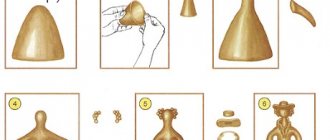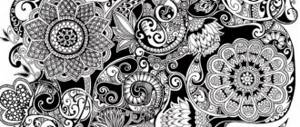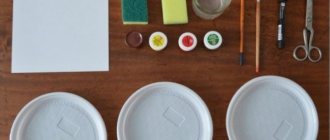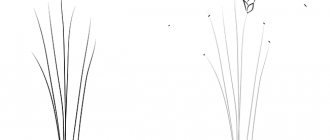Drawing with palms in the senior group: autumn still life. GCD summary, pictures for children, examples of children's work.
Palm painting is an unconventional painting technique that is commonly used with young children. But its capabilities are much wider. Today we will look at how you can use this non-traditional technique in teaching drawing to children of senior preschool age (senior and preparatory kindergarten groups).
Palm painting technique. You will need paints with the consistency of liquid sour cream. The paint is either applied to the child’s palm with a wide brush, or poured into a flat plate into which the child dips his palm. Next, palm prints are made on the paper and they are completed to the desired image. You can finish painting with your fingers or with a regular brush.
Author of the summary: reader of "Native Path" and participant in our competition "Autumn Workshop of Children's Crafts -2015" Lebedeva Elena Nikolaevna, teacher of additional education and teacher-organizer (Moscow GBOU School No. 324 "Firebird" DP kindergarten No. 215 and No. 179 ).
Tasks
— introduce the work of artists who depicted autumn still lifes,
- introduce the basics of color science, teach how to identify cold and warm colors and use shades in your works, introduce the term “saturated colors”,
- strengthen children’s ability to mix watercolor paints, obtain shades of colors and use them in drawings,
— develop children’s compositional skills: learn to place a composition on a non-standard sheet of paper, independently build a composition of a drawing and work it out in color,
— encourage children to boldly experiment, using a palette to mix colors, to find their own vision of the beauty of shapes and objects.
Practical part of the lesson, drawing a beautiful bouquet
During the lesson they draw a bouquet of flowers to give to their mother. Such lessons are defined as “direct educational activities” (DEA).
Age groups in kindergarten by year according to Federal State Educational Standards
GCD progress, what techniques can be used to apply an image
For depictions, children can use gouache drawing with a brush, as well as using their fingers and palms for this.
Drawing process step by step
The lesson scenario looks like this and is divided into several stages.
Introductory part
At the beginning of the lesson, the teacher reads a riddle poem to the children about how spring comes to replace winter. They answer that this happens in the spring.
The teacher asks about what holiday is happening at this time. Children talk about Mother's Day - March 8th. The teacher recites a poem about this holiday, then asks what can be given to mom on this day.
After discussing with the kids, they come to the conclusion that the best gift would be a beautiful bouquet of flowers. Then the children are shown illustrations with flowers prepared in advance.
There is a discussion about what parts plants have. They talk about leaves, stems, petals, their shape and color.
Physical education minute
Then the teacher offers to get up and rest a little using the so-called physical education minute. Music sounds, and children make certain movements to the poems.
“Chamomile, chamomile (children shake their heads) / Fragrant flower. / Yellow heart (springs) / White petal / With cold and wind (hands up, swaying) / The rains came again / And in the garden, like in summer (lean forward, holding hands to the sides) / Asters bloomed. / We are red carnations (the kids are marching), / Satin petals, / Slender legs (we hold our hands on our belts and stand on our heels), / Green boots.”
Main part
Children are asked to sit down and start drawing.
The teacher, together with the kids, repeats what flowers have (stems, leaves, flower petals). Discuss their color and shape.
Drawing flowers is done in different ways: some paint with a brush. Others use fingers and palms.
The kids make drawings for mommy on their own. The teacher watches how they act and helps with advice.
Then he looks at the resulting images of flowers, discusses and praises the kids.
Children draw
Preparing to paint an autumn still life
The teacher asks the children what time of year there are many bright and rich shades of warm colors in nature; nature literally breathes warmth. This time of year has always attracted artists, poets, and composers with its luxurious beauty; they admired this time of year and conveyed their admiration to people through their vision of the beauty of nature. How many famous people have left us their masterpieces in painting, poetry and music! What time of year do you think it might be? (autumn). What time of year is it now? What autumn months do you know?
What is the difference between early autumn and golden autumn? (In September, autumn is just beginning. The first yellow leaves appear on birches, maples bloom with yellow and red foliage. They say about such an autumn - early autumn. In October, all the trees dress up in autumn outfits, the leaves begin to fall. They say about such an autumn - golden, lush autumn ).
How do we know that late autumn has arrived? (In November, there is almost no foliage on the trees, there are frequent cold rains, frosts set in, and the first snow falls. This is called late autumn).
Autumn has its own colors. What colors of golden autumn do you know? (Red, yellow, orange, green, purple, warm, crimson, golden).
More useful materials for talking with children: A selection of poems about the colors of autumn for drawing classes with preschool children can be found here in the article about drawing an autumn forest using the technique of leaf prints on paper.
The teacher invites children to draw an autumn still life and shows how adult artists and children who are learning to be artists draw still lifes.
How to analyze these still lifes with children: The teacher shows the children a table with warm and cold colors and the still life invites them to think through what color palette the artist tells us about autumn in his still life. Does this painting have more warm or cool colors and shades?
At the end of the conversation, the adult asks: “What colors will you use to tell your story about autumn in your future still life? Think about it, and you and I will begin to draw an unusual autumn still life.
The still life will consist of maple leaves that stand in a vase. We will draw maple leaves using our palms.”
Fine arts lesson on the topic “Flowers for Mom” in middle groups of kindergarten
In this lesson, children draw flowers in order to give a picture to their mother. To do this, you can use gouache painting or use the appliqué technique.
Bouquets for mom
Example of drawing lesson notes
On the first page of the summary they indicate who wrote it and for which preschool institution it was made. Indicate for what age such a lesson is intended.
Purpose and objectives of the lesson
You need to formulate the goal that you plan to achieve by conducting classes with kids.
The following are the tasks that will need to be completed. They can be divided into several groups: moral education, development of creative abilities associated with the development of fine motor skills, nurturing independence and self-confidence, and the desire to develop an interest in art.
Preparation
It is necessary to indicate what should be used in these classes. It should be taken into account that each child should receive handouts for work. You will also need demonstration equipment and materials with which the teacher will teach the children.
Usually, shortly before the main lesson, a preparatory lesson is held, during which the children are given additional information, trying to awaken interest in the topic of the lesson and the technique of performing the work. For a drawing lesson you need paints, brushes, sheets of drawing paper, jars of water and wet wipes.
Note! In order to draw a bouquet correctly, you will need a sample drawing.
Preliminary lesson
On it they talk with kids about the holiday of March 8th. Children and the teacher observe the growth of flowers in the garden or flowerbed. Kids are taught about the structure of plants and shown their parts (stem, petals, etc.) and told about various techniques for drawing flowers.
Main part
The outline then describes how the main lesson should proceed. It is convenient to format this description as a table with three columns. On the left, they indicate which part of the lesson this relates to: introductory, main or final. The central column indicates what actions the teacher should take, and the right column describes the expected response of the children. To depict flowers, you can use not only painting with a brush or fingers, but also with cotton swabs.
We need to remember this
Important! In the final part, questions are asked to reinforce the material, the work is discussed and the teacher praises the children.
How to teach children to solve problems in mathematics in a preschool educational institution
We must remember that it is important that the lesson “Drawing: Flowers for Mom in the Middle Group” is exciting for kids. To do this, they need to be supported and praised. In the lesson, it is necessary to use all opportunities to make it interesting for children.
Exhibition of drawings
What event can the lesson be timed to coincide with?
Children's poems are read to kids about how the snow melts and how spring replaces winter. Then they ask about what month this happens. The children answer that in March. The teacher asks them to say what holiday is in March. The kids say that this is Mother's Day, the eighth of March.
The teacher offers to come up with a gift that can please the mother. After discussion, everyone comes to the conclusion that they can give her a painted bouquet of flowers.
How and what to draw on
You don't need any expensive equipment to work - you only need a minimum set.
Note ! Finger dyes have a gel-like structure and do not require additional dilution with water.
They do not spread, lay beautifully on the surface, allowing you to create original images, so it is convenient for children to create with them, and the workplace remains relatively clean after work. They are easy to wash from any surface and wash off clothes.
Creativity can be practiced on a wide variety of materials: paper, cardboard, glass, fabric, and even your own body.
Winter is a season that children love to display. For the New Year, you can come up with many interesting themes and create many finger paintings. Any winter stencil is filled with fingerprints. They can be completed with different shapes, and with the help of several fingers together you can create fluffy details.
A well-structured lesson plan will help organize children and help the teacher realize their goals. Children 3–4 years old are restless and active, so when preparing a lesson, the teacher thinks through the organizational aspects of the work so that there is no monotony. Drawing blanks for kids can be different. Children are able to trace ready-made stencils of simple shapes with a pencil.
Examples of literary leisure in secondary groups of kindergartens
Important! The kindergarten drawing cup template is one of the popular auxiliary materials for teaching children unconventional drawing. It is convenient to draw pea circles with your fingers on the cup.
Drawing on a cup helps children learn to evenly distribute the pattern on the cup, form the concept of “tea utensils,” expand their understanding of the utensils and what they are made of and what parts they consist of.
Children have developed visual and figurative thinking. Pictures and real utensils should be before the eyes of little artists. Demonstrating visual objects, the teacher accompanies this with a story, and preschoolers maintain a conversation about what they heard.
The benefits of finger art for kids
Scientists prove that the centers responsible for movement and speech development are located nearby. The activities of one center interact with another. Drawing accelerates children's development and teaches logical thinking. Using different colored dyes, they learn their names and learn that they can be mixed to create a completely new color.
The benefits of finger art in kindergarten are enormous:
- By working with their hands and fingers, children develop fine motor skills well.
- When children learn to draw with their fingers, it will be easier to teach them how to use pencils and felt-tip pens.
- Training your fingers and hands is a preparatory stage for the transition to working with brushes.
- By mixing finger dyes, the baby learns to obtain different shades.
- Drawing with hands and fingers for children provides a kind of reflex massage to strengthen the body.
- Teaches you to use figurative and abstract thinking and cognitive activity to create images.
- Develops perseverance, diligence, and patience.
Note ! The creative process not only develops fine motor skills in children, but also helps them develop speech.
Advice from Dr. Komarovsky: teaching a child to dress independently








